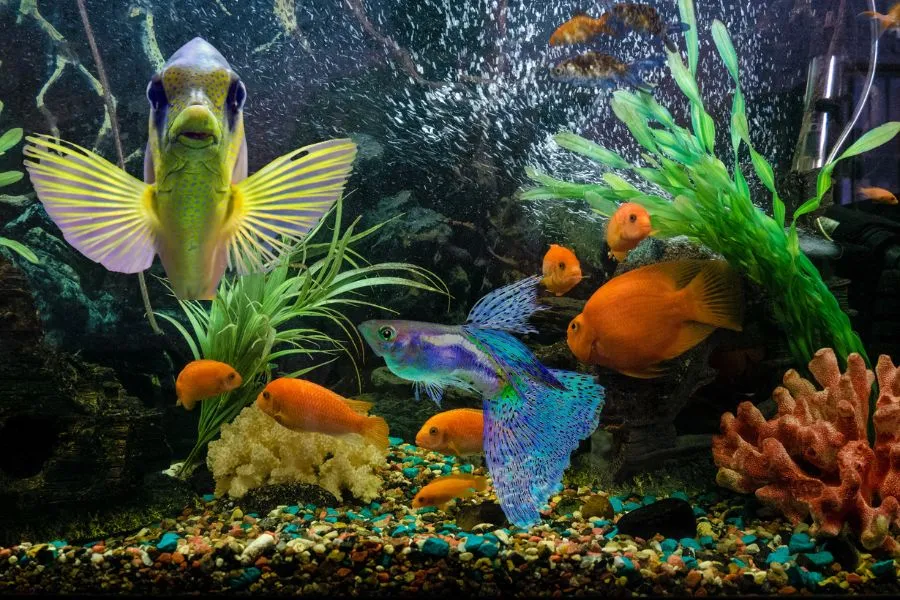Some might say that having fish as pets are easy and that it comes second to having a “real” pet like a dog, cat, or rabbit. However, a home aquarium or fish tank is no joke. There are a lot of choices and slip-ups from the owner that can cause problems. Some of the accessories you add to your fish tank might cause damage to your fish. Can driftwood cause fin rot?
Driftwood can be a culprit for causing fin rot. A parasite that naturally enters the tank through unclean equipment or any accessories from a natural source can introduce bacteria into the tank. Plants or second-hand equipment not cleaned properly have an even chance of infecting the tank.

Although driftwood is not the leading cause of fin rot, there is a chance that this may have been the source of the parasite. Therefore, you will have to research where your driftwood comes from and how to treat it before you add it to your tank to ensure no harm.
Driftwood and Fin Rot
Fin rot is a severe disease in fresh and saltwater fish and can lead to your aquarium fish dying off one by one. If you suspect it might be your driftwood, there are a few things to consider and investigate before you can point the finger at your driftwood.
Driftwood brings a great vibe and look to your tank, and fish love having it around. It sets a more natural tone for the fish, develops a living biofilm the fish can feed on, and gives them a place to hide, and those who lay eggs feel safer between the driftwood branches and holes. Still, bacteria might be lingering, ready to infest any fish with an open wound.

How Do You Know Your Fish Have Fin Rot?
First, you must identify whether it is fin rot or something else. It would be devastating to remove the driftwood from the tank and realize it was a different disease. Luckily, the owner or a vet can identify fin rot by visual characteristics.
The fins start to turn black at the edges and move closer, turning blacker as it progresses. The back fins, at the bottom, will show bulging red ulcers where it meets the body showing blood infection. There are ways to treat it; the sooner you discover it, the better the chance to treat it. If left untreated, your fish can lose their fins which is fatal to fish.
How Do I Know If Driftwood Caused Fin Rot?
You won’t know if the driftwood caused the fin rot or if it was something else. The best would be to track your driftwood back to the source. Did you buy it from a local or pet store, order it online, or pick it up in the woods on one of your morning walks?
Most pet shops or stores selling driftwood specifically for aquariums know the risk of these parasites, and they always treat the driftwood to be ready to add to the tank. The problem arises when you buy it from a store or online that might not specify it for fish tanks.

The biggest problem is picking up any piece of driftwood that looks like it will compliment your aquarium and stuffing it in there.
If the latter mentioned driftwoods are the ones in your tank, they might have caused the fin rot parasites, and no one would know which organisms were snuggled up inside that driftwood when you got it.
Safe Driftwood To Prevent Fin Rot
Although driftwood is seldom responsible for fin rot, it won’t hurt to know for sure that the driftwood you put in is 100% safe. These are driftwood you bought for aquarium purposes specifically and treated to ensure it is clean from unwanted substances.
Many types of woods are safe for the fish tank, and you might have to research which ones will fit your idea for the fish tank and your budget. Some of these will be difficult to find and expensive. When picking up driftwood yourself, there are certain ones to avoid, as they are either harmful to your fish or speculated to be.
| Safe Driftwood And Plants For Fish Tank | Unsafe Driftwood And Plants For Fish Tank |
| Marsh root | Cedar |
| Mopani wood | Spruce |
| Manzanita | Ivy |
| Cholla wood | Lavender |
| Sumatran driftwood | Walnut |
| Bogwood | Pine |
| Spider wood | Yew |
| Jangle wood | Cypress |
| Redmoor root wood | |
| Malaysian driftwood | |
| Bonsai trees | |
| Tigerwood |


Curing The Driftwood To Prevent Fin Rot
Even when you get a safe wood type, you still need to treat it to ensure there is no tannin discharge making the water brown or black (not harmful for the fish, but hey, most of us want a clear view of our fish family). Another reason for curing the wood is to prevent any unwanted bacteria from entering your fish tank and infecting the water.
The most popular process when cleaning driftwood before adding it to the tank is curing it in distilled water.
Step 1: Use a pressure washer or hold the piece of driftwood under a tap of running water
Step 2: Place the driftwood in a big container and add distilled water to cover the whole piece.
Step 3: Leave it to soak for one to two weeks.
Step 4: Some wood types will release tannins into the water; replace the water each time this happens until no more tannins are released.
Step 5: Add bleach to distilled water, two teaspoons per gallon, and soak for an hour or two. The bleach will help to remove any unwanted bacteria – thus, a critical step to ensure the driftwood is not responsible for fin rot.
Step 6: Repeat distilled water only soak again to remove any traces of the bleach.
Cleaning Wild Driftwood
Suppose you got a piece of driftwood from a natural source or picked it up; the cleaning will be more extensive to ensure you remove all the sand, debris, and living creatures.
Step 1: Shake off any dirt and peel off loose bark from the piece of driftwood.
Step 2: Use a wet toothbrush, screwdriver, or knife to remove excess sand and substances between the cracks and in the holes of the driftwood.
Step 3: Use light sanding paper to remove the outer layer of the piece of driftwood. Be gentle not to break off a bit.
Step 4: You can start with the normal curing process mentioned above.
Suppose you suspect your driftwood might have been the culprit; the best would be to remove it as soon as possible, clean the tank thoroughly, add new water, and look after the infected fish in a separate tank. You can opt for a new piece of driftwood and follow the curing steps.
Causes Of Fin Rot In Fish Tanks
Although driftwood might be the cause of introducing the bacteria into the tank, fish will mostly get fin rot when they have open wounds where these parasites can manifest. Thus, any other piece of equipment in your tank that can lead to fish hurting themselves or getting wounded may cause them to get fin rot in this way.
Other indirect causes of fin rot include overfeeding the fish, overcrowding the tank, poor choice of food that isn’t nutritious enough, adding aggressive fish that might fight with the other fish, and the aquarium’s water quality. These factors lead to stressed fish, increasing the chance of fin rot.
Conclusion
Driftwood makes a statement in your tank, and you can add it confidently when you know you have followed the steps to cure it. Avoid any reasons to worry about fin rot by keeping the tank’s water quality in check and ensuring your fish live in harmony with no reason to be stressed.
Check out the article ‘How long to Boil Driftwood to remove tannins‘ next.


